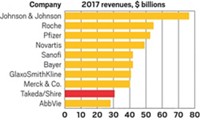Advertisement
Grab your lab coat. Let's get started
Welcome!
Welcome!
Create an account below to get 6 C&EN articles per month, receive newsletters and more - all free.
It seems this is your first time logging in online. Please enter the following information to continue.
As an ACS member you automatically get access to this site. All we need is few more details to create your reading experience.
Not you? Sign in with a different account.
Not you? Sign in with a different account.
ERROR 1
ERROR 1
ERROR 2
ERROR 2
ERROR 2
ERROR 2
ERROR 2
Password and Confirm password must match.
If you have an ACS member number, please enter it here so we can link this account to your membership. (optional)
ERROR 2
ACS values your privacy. By submitting your information, you are gaining access to C&EN and subscribing to our weekly newsletter. We use the information you provide to make your reading experience better, and we will never sell your data to third party members.
Business
Pharmaceuticals: Big Firms Will Fight The Patent Cliff
by Lisa M. Jarvis
January 11, 2010
| A version of this story appeared in
Volume 88, Issue 2
As a wave of patent expiries on major products approaches big pharma’s shores, industry observers are calling 2010 the year of the patent cliff. Companies will continue to look for partners and purchases, both big and small, to offset the looming decline in sales.
COVER STORY
Pharmaceuticals: Big Firms Will Fight The Patent Cliff
Among the drugs facing generic competition this year are Pfizer’s Alzheimer’s treatment Aricept, Merck & Co.’s hypertension medicine Cozaar, and Sanofi-Aventis’ breast cancer drug Taxotere. And by 2012, several firms will have lost protection on their most lucrative products, including Eli Lilly & Co. (Zyprexa), Bristol-Myers Squibb and Sanofi-Aventis (Plavix), and AstraZeneca (Seroquel). Most critically, Pfizer will face competition on Lipitor, the cholesterol-lowering drug that raked in nearly $13 billion in 2008.
Companies are using a range of tactics to stem the pending revenue drain. Last year brought three high-profile deals meant to buttress portfolios and pipelines: Pfizer paid $68 billion for Wyeth, Merck bought Schering-Plough for $41 billion, and Roche forked over $47 billion for the 44% of Genentech it did not already own.
Yet even with this latest round of merger and acquisition (M&A) activity, no single firm commands more than 8% of the global prescription drug market, notes G. Steven Burrill, head of the venture capital and merchant banking firm Burrill & Co. “That would generally indicate that we have a ways to go on consolidation,” he adds.
“There’s definitely a couple of large M&A events left in big pharma,” agrees Simon King, senior analyst at the health care consultancy Datamonitor.
King points to two companies that sat out the merger frenzy of the past decade. Managers at Lilly and Bristol-Myers focused on smaller biotech acquisitions and swore they weren’t interested in bigger deals. However, they are now the smallest of the top-tier players, and King sees a potential shift in strategy going forward.
In 2010, big companies will continue to mine the pipelines of small biotechs to help sustain growth. In a positive twist for big pharma, the challenging funding environment for small firms will create some bargains.
Burrill notes that 2009 turned out to be the second-largest financing year in biotech history. Still, gloomy markets meant that small firms, unable to raise cash from stock offerings or venture capitalists, were forced to accept less favorable terms from partners or acquirers. In 2010, those harsh realities will persist.
Also this year, drug companies will continue to look to emerging markets for growth, Datamonitor predicts. In addition to India and China, where many firms increased their stake in 2009, Latin America, Central and Eastern Europe, and Turkey will be important acquisition locales for big pharma in 2010.






Join the conversation
Contact the reporter
Submit a Letter to the Editor for publication
Engage with us on Twitter